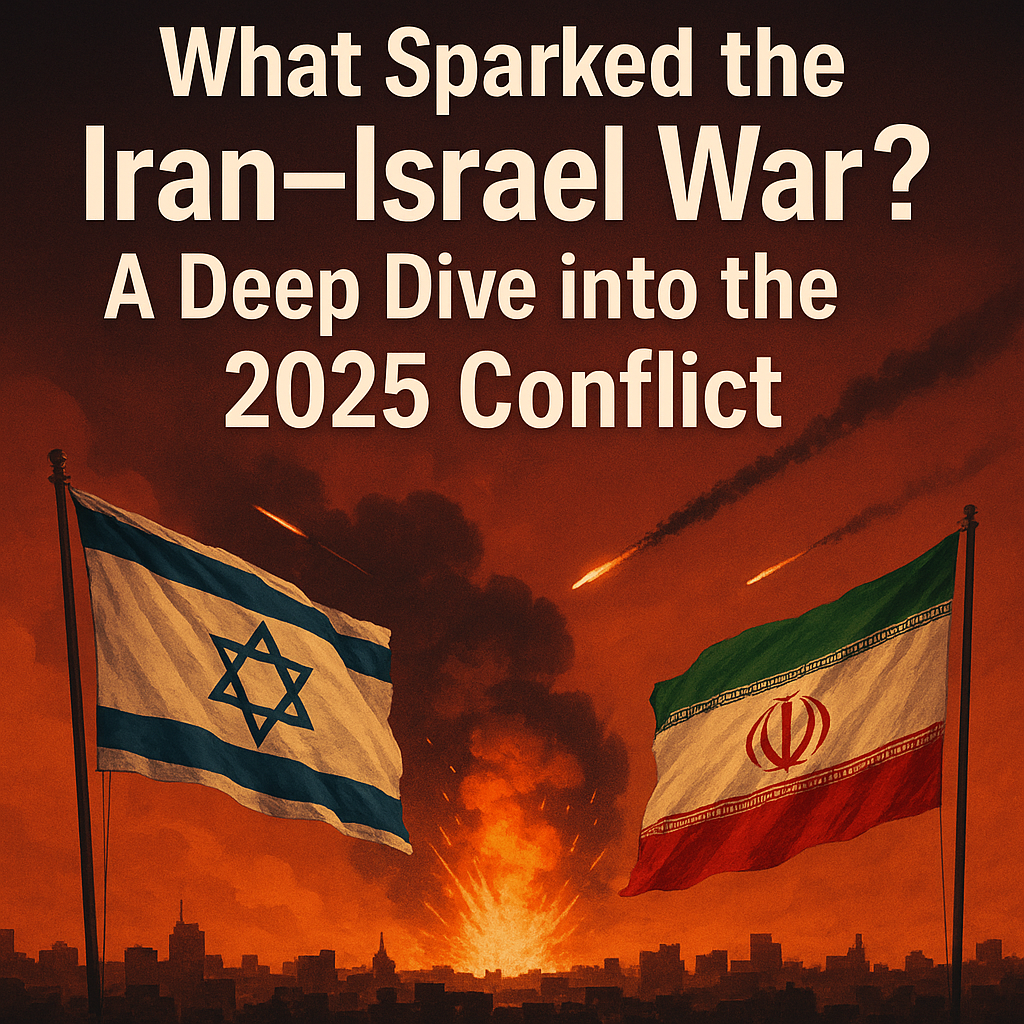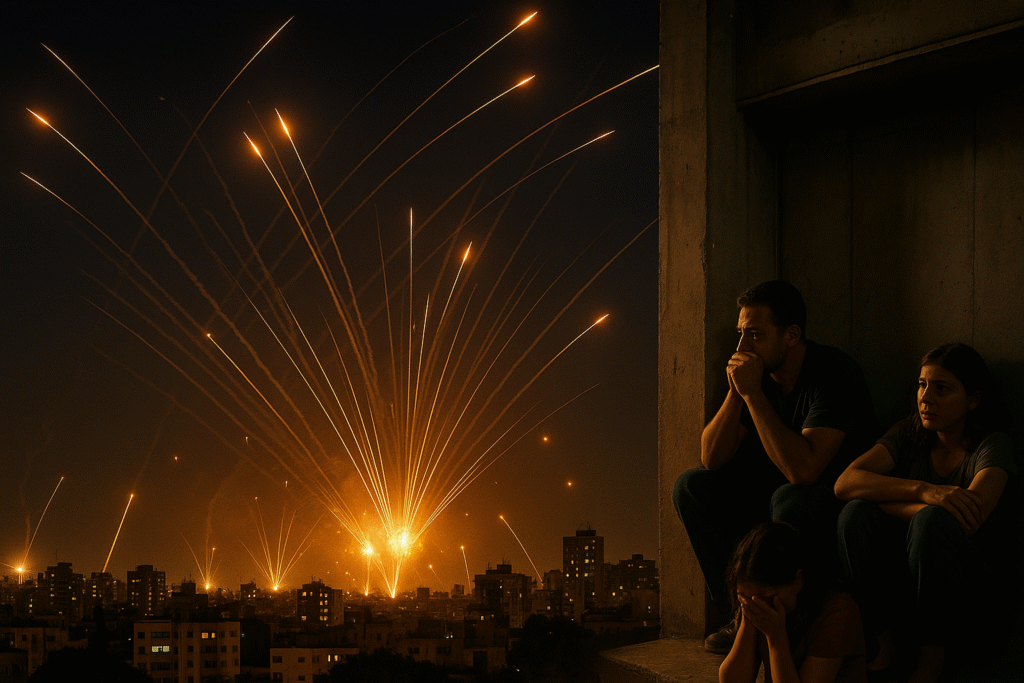
In june 2025, a major escalation took place between Israel and Iran, as one of the hottest military conflicts in Middle East history. This 12 day war rocked world markets, tested international relations and opened the question of regional security and the threat of expanding war. In this lengthy article, we discuss what caused the conflict, its chronology, main participants, and the aftermaths, as well as having our say about the impacts of the conflict on world peace.
1. History and Apprehensions
The Iran-Israel feud traces back to several decades ago and was founded by an ideological discord and competing regional interests. Ever since the Islamic Revolution in Iran in 1979, the country has denied the statehood of Israel and has been in open support of anti-Israel groups like the Hezbollah and Hamas. To counter this, Israel has tried to minimize the influence of Iran with clandestine operations, sanctions campaigning, and attacks by military forces.
One of the historical sources of conflict is the nuclear program of Iran. Although Iran maintains that it is peacefully intended, this is perceived by Israel and its allies as an open threat. Israel has in the previous years carried out sabotage operations and airstrikes to interfere with Iranian nuclear interests. This mistrust has been escalated by each advance in nuclear enrichment and proxy war games.
2. Immediate Causes: Nuclear Flashpoint
On June 12, 2025, the International Atomic Energy Agency (IAEA) formally announced Iran to be violating its non-proliferation obligations. This was also announced following Iranian movements of locking up inspectors to some of the vital facilities besides commencing high-level uranium enrichment. There were expressions of concern by the world community especially the U.S and Israel.
Israel regarded this as a red line. On June 13, it initiated an integrated airstrike named “Operation Rising Lion” by attacking more than 100 sites in Iran including Natanz, Isfahan and other important installations of the IRGC (Islamic Revolutionary Guard Corps). This dramatic step was a message meant to put across that no progress towards nuclear weapons was going to be condoned.
3. Iranian Retaliation

Iran responded with more than 150 ballistic missiles and over 100 drones in Israeli attacks with targets on military bases, urban centers and infrastructure. Though the Iron Dome successfully blocked most of them, a number of the projectiles hit the centres of civilians, injuring dozens. There was also a psychological toll because most people in Israel had to be in bomb shelters for long periods of time.
4. U.S. Intervention
On June 22, the U.S. through operation midnight hammer utilized the stealth bombers and Tomahawk missiles and targeted the Iranian nuclear facilities. Although all these strikes were meant to put Iran back in terms of its nuclear program, intelligence reports, later on, pointed to the fact that the current program was delayed by a few months only. However, the intervention was a demonstration of how America cared about Israeli security and stability in the whole region.
5. Muscles and Civility Crippling and Destruction of Infrastructure
The hostile conflict led to great human resources and material losses:
- Iran claimed more than 600 deaths and 1,300 casualties, the majority being civilians.
- Israel encountered 28 deaths and severe destruction of infrastructure, such as houses, hospitals and other public buildings.
- There were attacks on various oil refineries and data centres interfering with the economy of the two states.
6. Peace and Negotiations
On June 24, 2025, a ceasefire was mediated by the U.S., Qatar and European Countries. Iran signed an agreement to stop the missile attacks and then Israel. Diplomatic relations are strained as long as the cease fire persists. The main stakeholders are said to be the subject of secret negotiations in Geneva and Vienna.
7. Who are the people behind it? Proxy actors and Strategic Interests

The operations of Iran are included in a larger project in the region, the so-called axis of resistance, with Hezbollah, the Houthis in Yemen and Iraqi militias. Such groups allow Iran to exercise power without a number one faceoff. According to intelligence reports, Iranian weapons and some cyber forces contributed to the sharp increase in digital war.
Israel, it is also said, collaborated with the Mossad and the U.S. intelligence to set up secret drone outposts in Iranian land. The American administration contributed activities through surveillance and logistical assistance and thus it was a key but passive role player. In some claims, Israel cyber units hacked parts of Iran’s command system during the attacks.
8. Is It the Beginning of World War 3?
Experts, though, note that this is not a global war yet, in spite of the intensity. Nevertheless, this threat exists when there is direct involvement of other powers such as China or Russia. In response, both countries have called upon the de-escalation, threatening that more instabilities might destabilize world peace. The NATO countries are keeping a neutral stand, so far with close interest in the situation.
9. Economic and Political Impact
- During the conflict oil prices rose by 15 percent before settling down after the cease fire.
- The parliament of Iran has discussed the possibility of withdrawing out of the Nuclear Non-Proliferation Treaty (NPT).
- There have been efforts by the international community on restarting negotiations on Iran nuclear which have failed.
- The financial markets in Israel were witnessing a short-term slump which was reversed.
- Stocks that were highly successful were: U.S. defense stocks and cybersecurity companies.
10. Cultural and social impact
The populace in these two countries are very alienated. Citizens of Israel demonstrate a more acute sense of insecurity, and people of Iran now have to endure even more economic scarcity with international sanctions cursing them and warfare destroying their economy. The nationalistic rhetoric and misinformation increased in social media channels in both nations and contributed to the confusion and fear among the people.
11. Construction of a Culture of Financial and Civil Empowerment
One of the major lessons is that society needs its resilience. Business, society, and the government needs to promote educational services, mental health and financial wellbeing to enable the citizens to face times of crisis. Post conflict survival and reconstruction is easier with empowered and informed citizens. Humanitarian organisations and non-governmental organisations have called for more attention on after-war trauma treatment.
12. Prospects: Where Will That Take Us?
The war between Iran and Israel in 2025 was not a military contest only but a battle of ideologies, strength and survival tactics. Although direct aggressions have been stopped, tensions have not yet been resolved. It is only through the continued diplomacy, strategic patience and international coordination that the situation may not aggravate. The world looks on and these two regional powers redefine the future of stability in the Middle East.
Read More: Biztechtime.com


